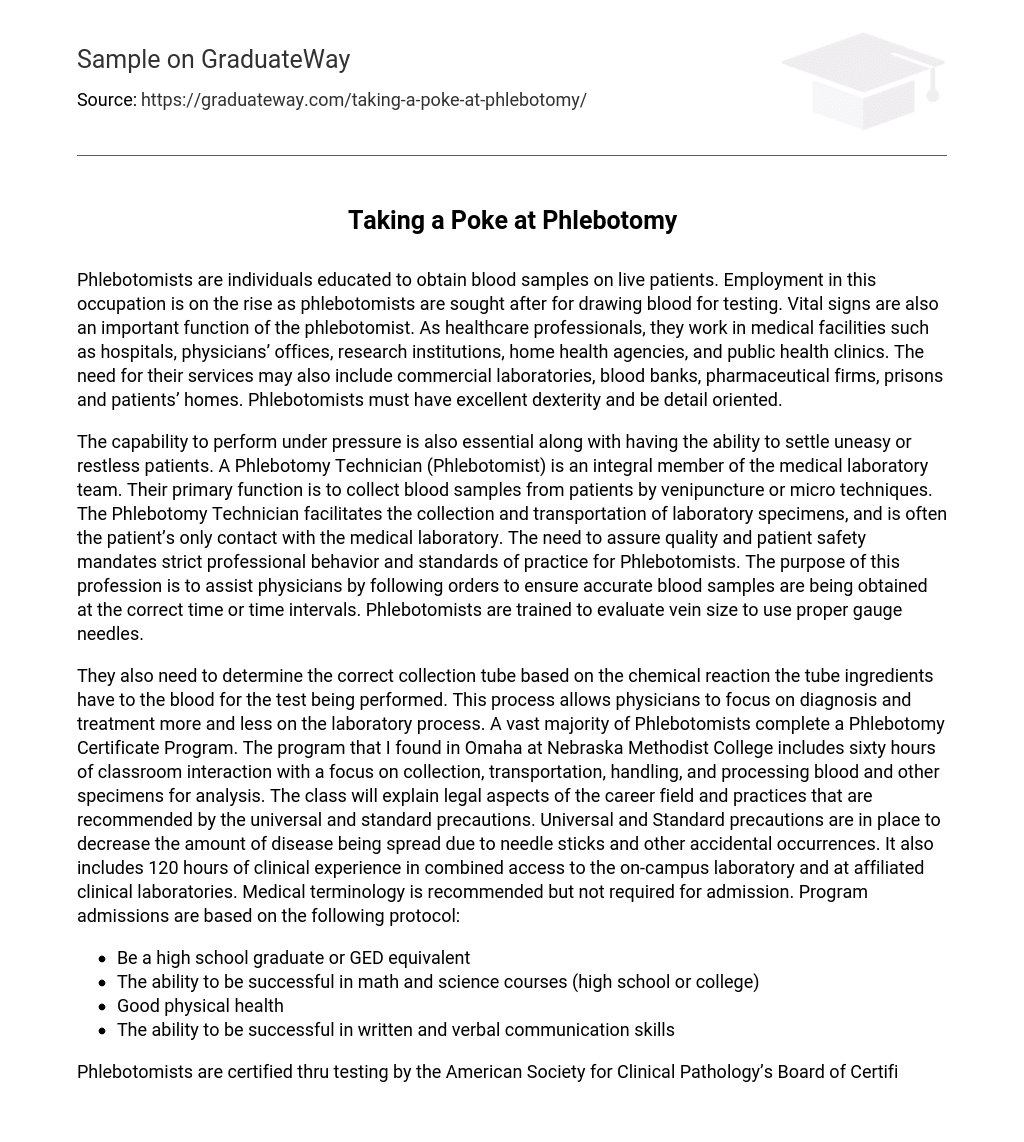Phlebotomists are individuals educated to obtain blood samples on live patients. Employment in this occupation is on the rise as phlebotomists are sought after for drawing blood for testing. Vital signs are also an important function of the phlebotomist. As healthcare professionals, they work in medical facilities such as hospitals, physicians’ offices, research institutions, home health agencies, and public health clinics. The need for their services may also include commercial laboratories, blood banks, pharmaceutical firms, prisons and patients’ homes. Phlebotomists must have excellent dexterity and be detail oriented.
The capability to perform under pressure is also essential along with having the ability to settle uneasy or restless patients. A Phlebotomy Technician (Phlebotomist) is an integral member of the medical laboratory team. Their primary function is to collect blood samples from patients by venipuncture or micro techniques. The Phlebotomy Technician facilitates the collection and transportation of laboratory specimens, and is often the patient’s only contact with the medical laboratory. The need to assure quality and patient safety mandates strict professional behavior and standards of practice for Phlebotomists. The purpose of this profession is to assist physicians by following orders to ensure accurate blood samples are being obtained at the correct time or time intervals. Phlebotomists are trained to evaluate vein size to use proper gauge needles.
They also need to determine the correct collection tube based on the chemical reaction the tube ingredients have to the blood for the test being performed. This process allows physicians to focus on diagnosis and treatment more and less on the laboratory process. A vast majority of Phlebotomists complete a Phlebotomy Certificate Program. The program that I found in Omaha at Nebraska Methodist College includes sixty hours of classroom interaction with a focus on collection, transportation, handling, and processing blood and other specimens for analysis. The class will explain legal aspects of the career field and practices that are recommended by the universal and standard precautions. Universal and Standard precautions are in place to decrease the amount of disease being spread due to needle sticks and other accidental occurrences. It also includes 120 hours of clinical experience in combined access to the on-campus laboratory and at affiliated clinical laboratories. Medical terminology is recommended but not required for admission. Program admissions are based on the following protocol:
- Be a high school graduate or GED equivalent
- The ability to be successful in math and science courses (high school or college)
- Good physical health
- The ability to be successful in written and verbal communication skills
Phlebotomists are certified thru testing by the American Society for Clinical Pathology’s Board of Certification (ASCP-BOC). Once the test is taken and passed the individual then holds the credentials PBT (Phlebotomy Technician). As previously mentioned in the education section, the job duties that are involved in this job include a vast amount of detail and patient interaction. It is important to not give the patient false reassurances. Phlebotomists receive an order or requisition form from the physician or ordering medical professional. Once the order is verified, phlebotomists create labels for the blood tubes that will be used.
This will ensure that when the tubes are sent for testing, they are not mixed up or lost. Some facilities have automated systems that print the labels in the lab when the order is inputted. While protecting themselves and the patient the technician obtains the samples. It is important to keep the patient at ease. Some patients will be nervous or stressed and this may cause some anxiety for the phlebotomist. Once the samples are all obtained, the tubes are labeled and distributed per protocol to the laboratory for analysis. It is important to look at the negative aspects of the career. Since these technicians deal with bodily fluids daily, they are at a high risk for infectious diseases. These can be decreased by using safety standards.
A second downfall to this profession is the pay. On average the pay for a phlebotomist ranges from twelve-fifty to fourteen dollars an hour. One of the downfalls that I noticed was the hours. Although you can work in a doctor’s office or laboratory, the hours for most technicians include early mornings and night shifts. This is due to the need for phlebotomists in hospital settings. It is necessary to determine what hours you will be willing to work before you chose what career setting you prefer. There are positives to the career as well. Although hours may be a negative to some individuals, I can also see it as a positive. Since the profession is needed at all hours, you can find a job working the hours that you chose depending on what setting you prefer. There are many options for hours in this field since physicians are always on call or always on staff in hospitals and long term care facilities and can order laboratory work from anywhere. Another positive to this career is people interaction.
If you like to be around people and meet new people on a daily basis, you can do so in this career field. To some that may be a downfall and they may wish to stay in home health or long term nursing care so they have the opportunity to stick with the same clients more frequently. A high positive to this career field is the demand. There will never be a time when the phlebotomist is not needed. Phlebotomy careers are vital to a society where the health care field is expanding.





